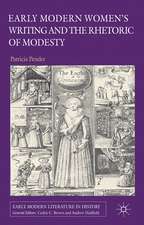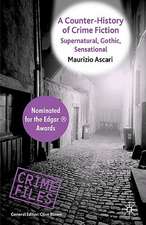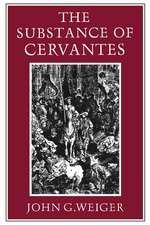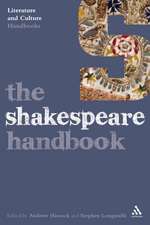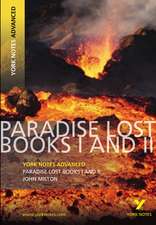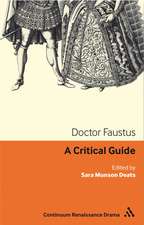Cervantes' Don Quixote: A Reference Guide
Autor Howard Mancingen Limba Engleză Hardback – 29 apr 2006 – vârsta până la 17 ani
Preț: 274.97 lei
Preț vechi: 499.19 lei
-45% Nou
Puncte Express: 412
Preț estimativ în valută:
52.62€ • 55.07$ • 43.79£
52.62€ • 55.07$ • 43.79£
Carte tipărită la comandă
Livrare economică 31 martie-14 aprilie
Preluare comenzi: 021 569.72.76
Specificații
ISBN-13: 9780313333477
ISBN-10: 0313333475
Pagini: 248
Dimensiuni: 156 x 235 x 25 mm
Greutate: 0.52 kg
Editura: Bloomsbury Publishing
Colecția Greenwood
Locul publicării:New York, United States
ISBN-10: 0313333475
Pagini: 248
Dimensiuni: 156 x 235 x 25 mm
Greutate: 0.52 kg
Editura: Bloomsbury Publishing
Colecția Greenwood
Locul publicării:New York, United States
Notă biografică
HOWARD MANCING is Professor of Spanish at Purdue University. His previous books include The Cervantes Encyclopedia (Greenwood, 2003).
Cuprins
Preface1. Introduction2. Content3. Texts4. Contexts5. Ideas6. Narrative Art7. Reception8. Bibliographical EssayBibliographyIndex
Recenzii
A respected Cervantes scholar and author of The Cervantes Encyclopedia, Mancing offers here a general introduction to Don Quixote. His prose is clear and easy to follow, and the information provided is as rich and comprehensive as it is comprehensible. The author includes a survey of Cervantes's life and times, the content of the novel, its various contexts and thematic emphases, the narrative art of the writer, and the reception of the work by readers and by authors conspicuously influenced by it. The concluding bibliographical essay provides a panoramic view of approaches to Don Quixote and looks at trends in scholarship and at key critical works. Full of useful data and syntheses, this thoughtful and beautifully balanced consideration of Don Quixote is presented in a format that allows Mancing to summarize his own reading of the text. Chapter 5, Ideas, for example, moves from literary influences and social practice as reflected in the novel to metafiction and interpolations, and chapter 6 complements that discussion with valuable commentary on narrative art. Though it is geared toward those initiating study of Don Quixote as advanced undergraduates, this reader-friendly guide should become a staple in all libraries. Essential. High-school readers through graduate students.
Mancing's reference guide provides an accurate, readable synopsis of Don Quixote's early publication history and the life of its 16th-century Spanish author, Miguel de Cervantes Saavedra. It is not organized in the traditional dictionary or encyclopedia format but instead written as a treatise consisting of eight chapters. One chapter summarizes the story, while others review the historical and social period; explore ideas, themes, and criticisms; discuss Cervantes's language, style, and technique; and examine the public's reception of the book. In addition to a comprehensive bibliography, each chapter has its own works-cited bibliography. All bibliographies list both Spanish- and English-language works, including those by scholars Harold Bloom, Manuel Duran, and Mancing himself. A detailed index provides easy access and cross references. Combined with the prodigious bibliography, the well-written plot summary, biographical information, and publication history make this affordable book an undergraduate's best friend. The treatise format is perfect for students needing broader information regarding Cervantes's writing style, themes, ideas, world, and social order in general. This book lets patrons choose a specific research method before tackling the more complex resources that frequently send them into interlibrary-loan land. Highly recommended for academic, public, and high school libraries.
Aimed at students and general readers, this reference provides background information on Miguel Cervantes' Don Quixote. Mancing opens the volume with an overview of Cervantes' life and major works, followed by a plot summary of Don Quixote. Other chapters review the novel's publishing history, place it within its social and historical contexts, and discuss its structure and main themes. A bibliographical essay offers suggestions for further reading.
Written by a leading scholar, yet accessible to high school students, this guide is an indispensable introduction to, arguably, the world's most important novel.
Mancing's reference guide provides an accurate, readable synopsis of Don Quixote's early publication history and the life of its 16th-century Spanish author, Miguel de Cervantes Saavedra. It is not organized in the traditional dictionary or encyclopedia format but instead written as a treatise consisting of eight chapters. One chapter summarizes the story, while others review the historical and social period; explore ideas, themes, and criticisms; discuss Cervantes's language, style, and technique; and examine the public's reception of the book. In addition to a comprehensive bibliography, each chapter has its own works-cited bibliography. All bibliographies list both Spanish- and English-language works, including those by scholars Harold Bloom, Manuel Duran, and Mancing himself. A detailed index provides easy access and cross references. Combined with the prodigious bibliography, the well-written plot summary, biographical information, and publication history make this affordable book an undergraduate's best friend. The treatise format is perfect for students needing broader information regarding Cervantes's writing style, themes, ideas, world, and social order in general. This book lets patrons choose a specific research method before tackling the more complex resources that frequently send them into interlibrary-loan land. Highly recommended for academic, public, and high school libraries.
Aimed at students and general readers, this reference provides background information on Miguel Cervantes' Don Quixote. Mancing opens the volume with an overview of Cervantes' life and major works, followed by a plot summary of Don Quixote. Other chapters review the novel's publishing history, place it within its social and historical contexts, and discuss its structure and main themes. A bibliographical essay offers suggestions for further reading.
Written by a leading scholar, yet accessible to high school students, this guide is an indispensable introduction to, arguably, the world's most important novel.












